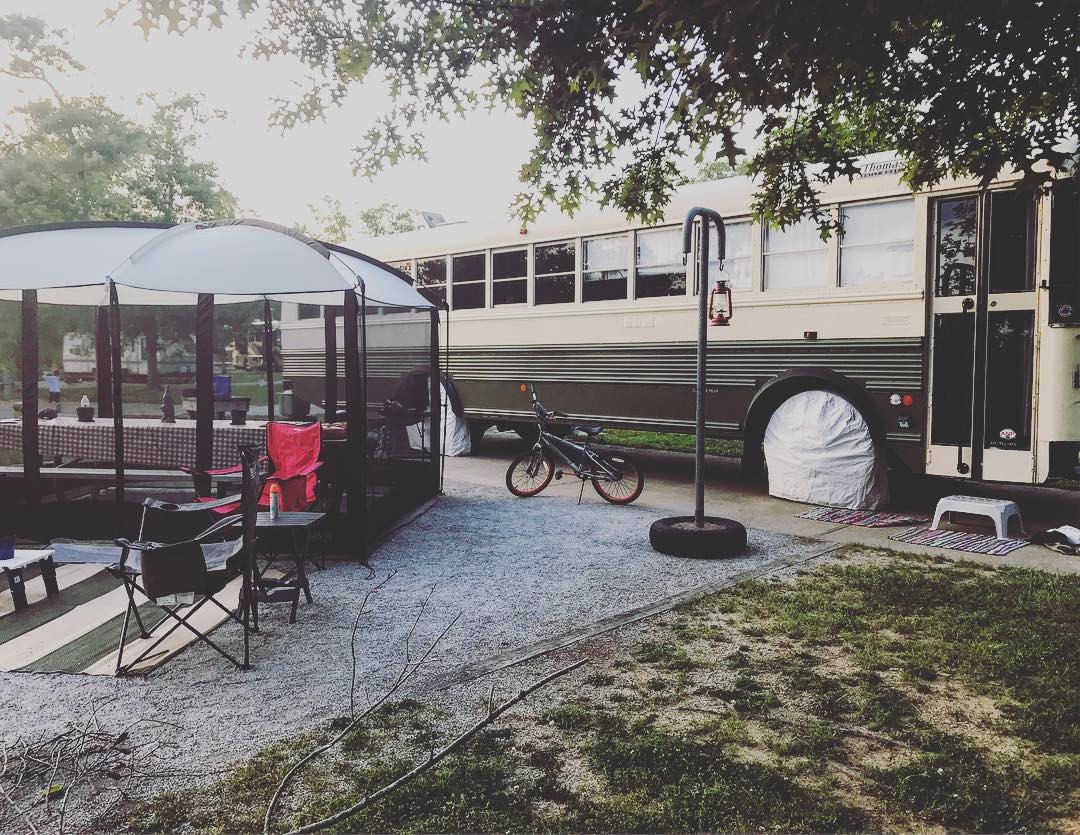Though we had some experience with RVs in the past, it wasn’t until we decided that we were definitely a family of camping enthusiasts that we got serious about getting one that met our travel needs. It’s a real trick to find an RV with a floor plan that meets the size of your family, has a decent build quality and comes in at an affordable price. RV manufacturers in the last few years have shifted their focus from the traveling retirees to the traveling family, so today you may have more options than we did two years ago in the used RV market. We were specifically looking for bunk rooms for our three boys. Even before we decided to be full-time travelers, we knew we’d travel for weeks at a time, and we wanted our boys to have their own personal space, not a bed that needed to be folded out from a dinette every night.
A lot of heavy YouTube research kept pointing me towards school bus conversions — or “skoolies” — to meet the needs of our family. After all, I figured I had the experience with carpentry and electricity to pull it off, even if I’d have to learn a thing or two about motor vehicles (never my forté) and plumbing. But seeing other folks build their dream on YouTube was really what lead me to believe I could build an RV for my family at a price we could afford that met all of our needs. Abby and I spent a few months researching and budgeted out our costs and decided to pull the trigger rather quickly.
As there wasn’t a lot of this info out there at the time, I thought it would be helpful to share for those who may be interested in taking this on what our rough costs of converting our 2002 Thomas school bus into a motorhome were.
School Bus: $3400
We drove to Ohio from Chicago to pick her up after an exhaustive search. School buses are in the $75,000 – $90,000 range new, but most states have laws that require them to be dropped from service after 15 years or so many miles, making the used market full of buses at rock-bottom prices. We were able to find the style we wanted (flat front – transit style, with more interior room than a traditional school bus) that was just removed from service, meaning the school district had kept it’s maintenance up. It only had 72,000 miles on it, and a minimal amount of rust.
uStorage land to build the bus on: $700
Living on the North side of Chicago we had zero places to park a bus, so we had to rent land from someone who would have zero issue with us making a mess and some noise. We found nowhere in the city that we could afford and ended up storing the bus an hour away in Hammond, Indiana on a storage lot. We had no power hook-up, so a generator was required, but we could come and go as we pleased and the land was gated and locked. For our situation, it ended up being the perfect set-up, but having a piece of land right out our front door would have been even better.
Generator: $500
We needed a generator as we had no power on site for the build, and figured we would just take it with us for boondocking (camping without hookups) on our travels.
Tools in addition to personal collection: $500
I was fortunate to go into this with a decent set of tools, but there were still plenty of needs and many we didn’t realize we required until we got into the build. If you feel that you have a healthy tool collection you can expect to spend around $500 more, but if you are starting from scratch try to borrow as much as you can to keep costs down, but expect to have expenses over $1,000.
Materials for build: $11,000
This includes all lumber, hardware, paint, electrical wiring, flooring, water lines and fixtures required to turn our bus into a home. In several places we saw our costs balloon, so it required us to think outside the box a bit, especially when it came to the more decorative features of the conversion (using thick sailor rope for trim as opposed to actual trim on many places around the ceiling. Wallpaper that looks like a tin ceiling design as opposed to actual tin ceiling plates).
Compost Toilet: $1,000
I made this its own separate entry because we opted to purchase a Nature’s Head Composting Toilet as opposed to utilizing an RV style toilet and a black tank. Many builders make their own compost toilets and there are plenty of articles on the subject, but we felt more comfortable going with a preassembled composting toilet, and it has been perfect for our families needs. For more info on why we love our Nature’s Head check out Episode 17 of the RV Miles Podcast.
Other furnishings: $2,000
This includes the mattresses for the bunks, cushions for the living room, kitchen electronics (new apartment size fridge and drawer dishwasher), storage crates or hooks, artwork, kitchen utensils, towel, sheets, etc. Many of these items we brough from our apartment, but others needed to be space-specific.
Tires: $2100
Big tires for a bus aren’t cheap, and they need to be replaced every seven years or so. Ours had hit the 10-year mark, and they had to go. We got a pretty good deal through a family connection, but you can expect to pay upwards of $3000 for a new set of tires installed.
Registering the school bus as an RV: $165
We were able to save a lot of time and headache by going to a Currency Exchange to convert the title. For more information on this see our GETTING LEGAL article.
New Transmission: $4200
Expect surprises. They will happen, and these are big vehicles that cost a lot to repair. Our transmission ate itself whole soon after we finished building the bus. You definitely need a budget for major repairs.
Total cost: $25,565 for a newly built custom motorhome. There were places we wish we’d cut back on and we went over our budget of $20,000, but we recognize there were repairs beyond our control and we had to go with the flow. Regardless, we love our home, and we feel a great sense of accomplishment in having designed a space that perfectly fits our family of five’s needs.
Want to see a walk-through of our converted school bus? Check out our YouTube video below:



2 Comments
Michele · January 8, 2019 at 1:00 pm
Thank you for sharing this info! I have wondered about the cost of a bus renovation. You couldn’t find a diesel RV for that price, and if you did, it would be the cookie cutter interior that would still need renovated. You put in the work and now have a gorgeous RV designed specifically for your family’s needs for a great price. I love it!
Epperson Family · January 9, 2019 at 12:40 pm
Thanks so much, Michele! Love that there are options out there that allow everyone to enjoy the RV lifestyle and get out on the road!
Comments are closed.